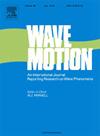On the energy flux in elastic and inelastic bodies and cross-coupling flux between longitudinal and transversal elastic waves
IF 2.1
3区 物理与天体物理
Q2 ACOUSTICS
引用次数: 0
Abstract
The energy balance equation, including not only the kinetic and deformation energy densities, but also the power of external forces, identifies the energy flux as minus the product of the velocity by the stress tensor: this result does not depend on constitutive relations and applies to elastic or inelastic matter. The simplest case is an isotropic pressure, when the energy flux equals its product by the velocity. In the linear case, the energy flux is obtained in elasticity for crystals and amorphous matter. An independent result is to show that, by inspection of any linear wave equation in a steady homogeneous medium, it is possible to ascertain whether the waves are (a) isotropic or not and (b) dispersive or not, with no need for an explicit solution. An application of this result to linear elastic waves shows that: (i) they are non-dispersive in crystals or amorphous matter; (ii) for the latter material, the longitudinal and transversal waves are isotropic, but their sum is not. A consequence of (ii) is that the superposition of longitudinal and transversal waves: () adds the two energy densities and powers of external forces; () adds, to the two energy fluxes, a third cross-coupling energy flux that is proportional to the dilatation of the longitudinal wave multiplied by the velocity of the transverse wave.
弹性体与非弹性体的能量通量及纵波与横向弹性波的交叉耦合通量
能量平衡方程,不仅包括动能和变形能量密度,而且还包括外力的力量,确定能量通量为负的速度与应力张量的乘积:这个结果不依赖于本构关系,适用于弹性或非弹性物质。最简单的情况是各向同性压力,当能量通量等于它与速度的乘积时。在线性情况下,能量通量在晶体和无定形物质的弹性中得到。一个独立的结果是表明,通过检查稳定均匀介质中的任何线性波动方程,可以确定波是否(a)各向同性和(b)色散,而不需要显式解。将这一结果应用于线弹性波表明:(1)它们在晶体或无定形物质中是非色散的;(ii)对于后一种材料,纵波和横波是各向同性的,但它们的总和不是。(ii)的结果是纵波和横波的叠加:(α)使外力的两种能量密度和功率相加;(β)在这两种能量通量的基础上增加了第三种交叉耦合能量通量,它与纵波的膨胀乘以横波的速度成正比。
本文章由计算机程序翻译,如有差异,请以英文原文为准。
求助全文
约1分钟内获得全文
求助全文
来源期刊

Wave Motion
物理-力学
CiteScore
4.10
自引率
8.30%
发文量
118
审稿时长
3 months
期刊介绍:
Wave Motion is devoted to the cross fertilization of ideas, and to stimulating interaction between workers in various research areas in which wave propagation phenomena play a dominant role. The description and analysis of wave propagation phenomena provides a unifying thread connecting diverse areas of engineering and the physical sciences such as acoustics, optics, geophysics, seismology, electromagnetic theory, solid and fluid mechanics.
The journal publishes papers on analytical, numerical and experimental methods. Papers that address fundamentally new topics in wave phenomena or develop wave propagation methods for solving direct and inverse problems are of interest to the journal.
 求助内容:
求助内容: 应助结果提醒方式:
应助结果提醒方式:


